Serving 463 students in grades Prekindergarten-12, Laurel Hill School ranks in the top 50% of all schools in Florida for overall test scores (math proficiency is top 30%, and reading proficiency is top 30%).
The percentage of students achieving proficiency in math is 64% (which is higher than the Florida state average of 52%). The percentage of students achieving proficiency in reading/language arts is 46% (which is lower than the Florida state average of 52%).
The student:teacher ratio of 14:1 is lower than the Florida state level of 17:1.
Minority enrollment is 23% of the student body (majority Black), which is lower than the Florida state average of 65% (majority Hispanic).
Quick Stats (2025)
- Grades: Prekindergarten-12
- Enrollment: 463 students
- Student:Teacher Ratio: 14:1
- Minority Enrollment: 23%
- Graduation Rate: ≥80% (Btm 50% in FL)
- Overall Testing Rank: Top 50%
- Math Proficiency: 64% (Top 30%)
- Reading Proficiency: 46% (Btm 50%)
- Science Proficiency: 40-44% (Btm 50%)
- Source: National Center for Education Statistics (NCES), FL Dept. of Education
School Overview
Laurel Hill School's student population of 463 students has grown by 21% over five school years.
The teacher population of 32 teachers has grown by 18% over five school years.
Grades Offered
Grades Prekindergarten-12
Total Students
463 students
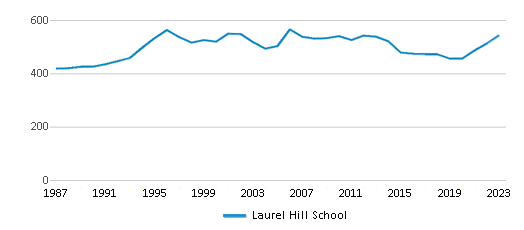
Gender %
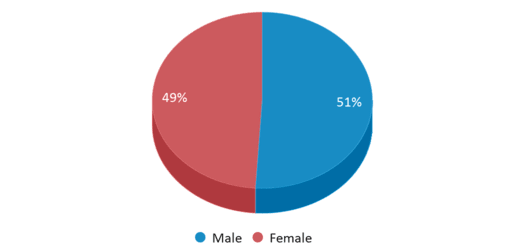
Total Classroom Teachers
32 teachers
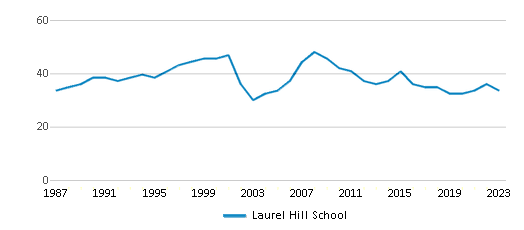
Students by Grade
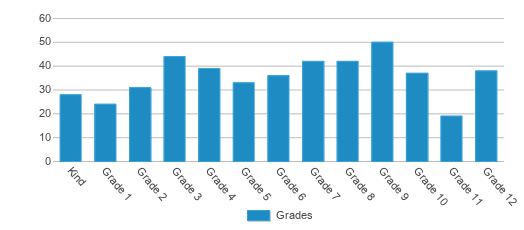
School Rankings
Laurel Hill School ranks within the top 50% of all 3,704 schools in Florida (based off of combined math and reading proficiency testing data).
The diversity score of Laurel Hill School is 0.39, which is less than the diversity score at state average of 0.70. The school's diversity has stayed relatively flat over five school years.
Overall Testing Rank
#1559 out of 3704 schools
(Top 50%)
(Top 50%)

Math Test Scores (% Proficient)
64%
52%
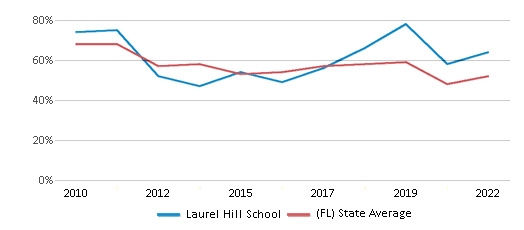
Reading/Language Arts Test Scores (% Proficient)
46%
52%
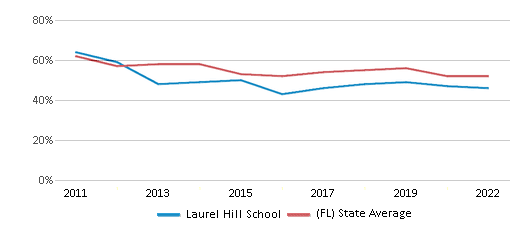
Science Test Scores (% Proficient)
40-44%
52%

Student : Teacher Ratio
14:1
17:1
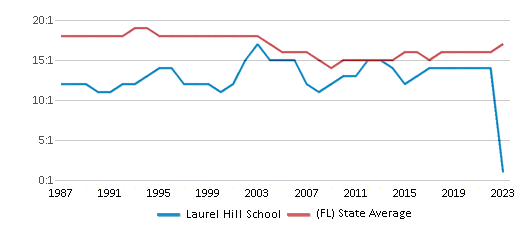
American Indian
n/a
n/a
Asian
2%
3%
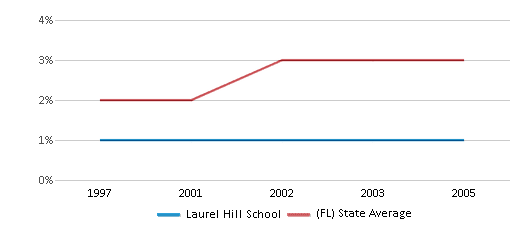
Hispanic
5%
37%
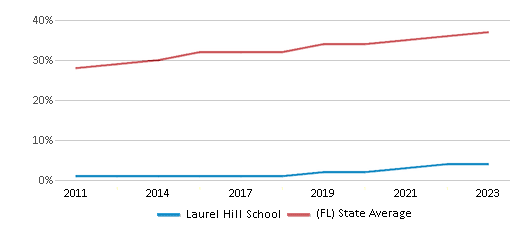
Black
10%
21%
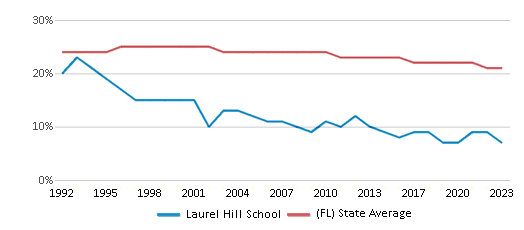
White
77%
35%

Hawaiian
n/a
n/a
Two or more races
6%
4%
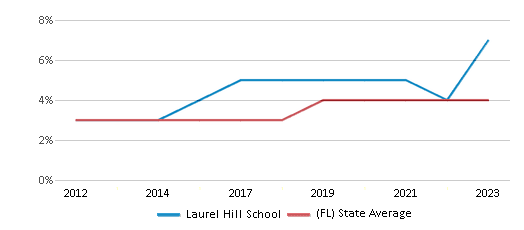
All Ethnic Groups
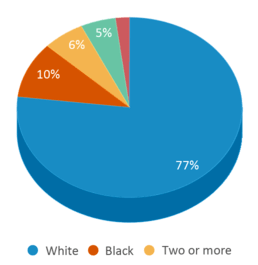
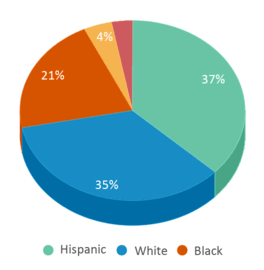
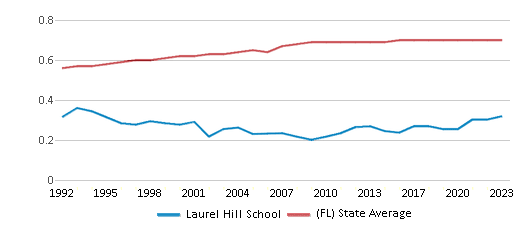
Graduation Rate
≥80%
87%
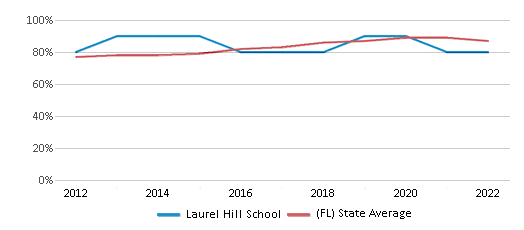
Participates in the National School Lunch Program (NSLP)
Yes
Eligible for Free Lunch
53%
47%
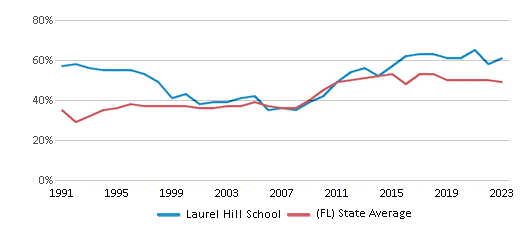
Eligible for Reduced Lunch
8%
4%
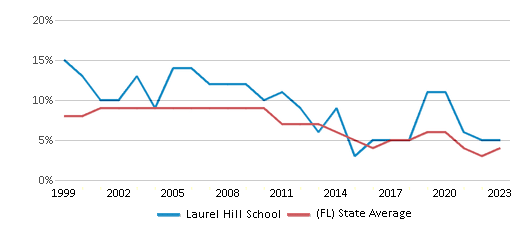
School Statewide Testing
School District Name
Source: National Center for Education Statistics (NCES), FL Dept. of Education
Profile last updated: 02/09/2025
Frequently Asked Questions
What is Laurel Hill School's ranking?
Laurel Hill School is ranked #1559 out of 3,704 schools, which ranks it among the top 50% of public schools in Florida.
What schools are Laurel Hill School often compared to?
Laurel Hill Schoolis often viewed alongside schools like Baker School by visitors of our site.
What percent of students have achieved state testing proficiency in math and reading?
64% of students have achieved math proficiency (compared to the 52% FL state average), while 46% of students have achieved reading proficiency (compared to the 52% FL state average).
What is the graduation rate of Laurel Hill School?
The graduation rate of Laurel Hill School is 80%, which is lower than the Florida state average of 87%.
How many students attend Laurel Hill School?
463 students attend Laurel Hill School.
What is the racial composition of the student body?
77% of Laurel Hill School students are White, 10% of students are Black, 6% of students are Two or more races, 5% of students are Hispanic, and 2% of students are Asian.
What is the student:teacher ratio of Laurel Hill School?
Laurel Hill School has a student ration of 14:1, which is lower than the Florida state average of 17:1.
What grades does Laurel Hill School offer ?
Laurel Hill School offers enrollment in grades Prekindergarten-12
What school district is Laurel Hill School part of?
Laurel Hill School is part of Okaloosa School District.
School Reviews
5 5/17/2016
Best school ever! Seen larger schools and they just don't give the students the one on one like Laurel Hill.
2 11/19/2007
As a parent and a child who attended 7 years. Academics are good. Would like to have seen more extracurricular activities. Facility is very neat/tidy. School teachers are great but do not communicate with parents and let them know about extreme changes in grades. School has changed principals 4 times in 7 years. Majority of students are WONDERFUL! However, my child was hit by a student who's parent was also a staff member of the school and no punishment. Another student also also sexually harrassed and assaulted my child and nothing good came of it. Another family member of mine was also the victim of TWO fights. One physical. Another was when students threw rocks at him. Principal refuses to hear parents side of explanations. School Resource Officer brown noses principals and does not appear to provide a safe environment for students. I pulled my child out Friday and not to return.
Review Laurel Hill School. Reviews should be a few sentences in length. Please include any comments on:
- Quality of academic programs, teachers, and facilities
- Availability of music, art, sports and other extracurricular activities
Recent Articles

What Is A Charter School?
Explore the world of charter schools in this comprehensive guide. Learn about their history, how they operate, and the pros and cons of this educational innovation. Discover key facts about charter schools, including admission policies, demographics, and funding, as well as what to look for when considering a charter school for your child.

10 Reasons Why High School Sports Benefit Students
Discover the 10 compelling reasons why high school sports are beneficial for students. This comprehensive article explores how athletics enhance academic performance, foster personal growth, and develop crucial life skills. From improved fitness and time management to leadership development and community representation, learn why participating in high school sports can be a game-changer for students' overall success and well-being.

February 05, 2025
Understanding the U.S. Department of Education: Structure, Impact, and EvolutionWe explore how the Department of Education shapes American education, from its cabinet-level leadership to its impact on millions of students, written for general audiences seeking clarity on this vital institution.









